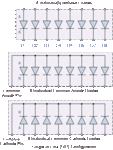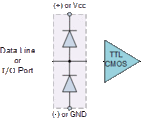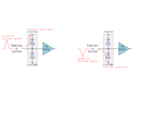RAHUL_KUMAR
Member level 5
- Joined
- Jun 5, 2017
- Messages
- 90
- Helped
- 4
- Reputation
- 8
- Reaction score
- 4
- Trophy points
- 8
- Location
- Bhubaneswar,Odisha,India
- Activity points
- 786
Signal diode arrays can also be used in digital and computer circuits to protect high speed data lines or other input/output parallel ports against electrostatic discharge, (ESD) and voltage transients.
By connecting two diodes in series across the supply rails with the data line connected to their junction as shown, any unwanted transients are quickly dissipated and as the signal diodes are available in 8-fold arrays they can protect eight data lines in a single package. ??
I want to know how will the two diode in series be able to protect from unwanted transients?
By connecting two diodes in series across the supply rails with the data line connected to their junction as shown, any unwanted transients are quickly dissipated and as the signal diodes are available in 8-fold arrays they can protect eight data lines in a single package. ??
I want to know how will the two diode in series be able to protect from unwanted transients?


